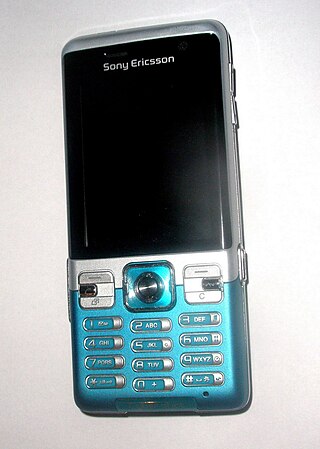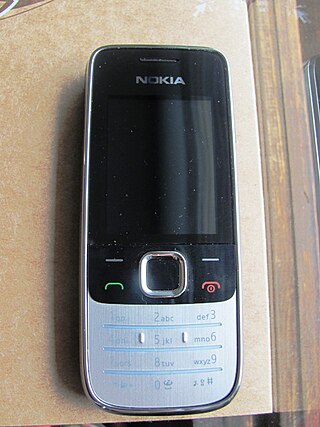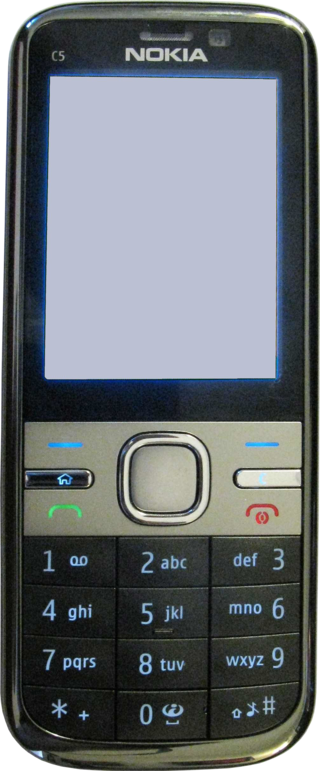
The Nokia 6230 is a mobile phone based on the Nokia Series 40 platform. It was announced on 28 October 2003 and released in February 2004.
The O2 Xda brand was a range of Windows Mobile PDA phones, marketed by O2, developed by O2 Asia and manufactured by multiple OEMs (mainly HTC, Quanta and Arima). The first model was released in June 2002. The last models came to market in 2008. The "X" represents convergence of voice and information/data within one product; the "DA" stands for "Digital Assistant", as in PDA. The name of XDA Developers is derived from it.
The Nokia 6270 is a late 2005 quad band mobile phone from Nokia. It is based on the Series 40 third generation platform, and features a 2 megapixel digital camera with 5x digital zoom and a flash, 9 MB of storage plus support for up to a 2 GB miniSD Card, and a 240x320 QVGA screen with 262,144 colors. Software includes a full XHTML compatible web browser, an email client and a media player.

The Nokia 3250 is a smartphone running Symbian OS v9.1, announced on 26 September 2005. It features a unique 'twist' design that transforms the traditional phone keypad into a camera and dedicated music control keys. It was marketed as a music phone and can store up to 2 gigabytes of music and other data thanks to a microSD memory card slot, and features a two-megapixel camera as well as other smartphone capabilities.

The Nokia 6233 phone made by Nokia is the successor to the Nokia 6230i. It is a 3G/GSM/WCDMA mobile phone that runs the Series 40 3rd Edition, Feature Pack 1 UI on the Nokia operating system.

The Nokia 6111 is a mid-level GSM mobile phone released in June 2005. It sold in Asia, Europe, Australia, Brazil and in Mexico, but was not taken by any carriers in the United States.
The Motorola Slvr is a former series of candybar mobile phones from Motorola, and was one of the series in the 4LTR line. The first phones were released in early 2005. Inspired by the Razr, they were designed to be very thin and lightweight.

The Sony Ericsson K850i is a high-end mobile phone when released in October 2007. It was announced in June 2007 as the flagship product in Sony Ericsson's K ("Kamera") series, with a 5 megapixel CMOS camera sensor. The K850 was the first Sony Ericsson phone released outside of NTT DoCoMo to support microSD and microSDHC along with Sony's traditional M2. It also introduces the usage of three touch-sensitive softkeys right under the display and a new form of navigation button, omitting the classic joystick introduced with the Ericsson T68. The camera interface has been revamped to resemble the format of cybershot digital cameras. According to the manufacturer the UMTS talk time has been significantly increased to 3 hours 30 min over its predecessor, the K800 and K810.. It was Sony Ericsson's first 3.5G HSDPA supporting mobile phone, and was also the first 3G "global" mobile with supporting all major operating network frequency in the world including GSM 850, GSM 900, GSM 1800, GSM 1900, HSDPA, UMTS 850, UMTS 1900, UMTS 2100.
The Sony Ericsson W580i is a mid range slider style mobile phone in the Walkman series. The phone was announced on 26 March 2007 and was released in early August. It is a 2.5G Quad-band (850/900/1800/1900) GSM phone with EDGE capabilities and has a 2 megapixel camera. It comes in "Style White", "Boulevard Black", "Metro Pink", "Urban Grey", "Jungle Green" and "Velvet Red".

Nokia 5300 XpressMusic is a slider mobile phone by Nokia, part of the XpressMusic range. It was introduced on 26 September 2006 and released at the end of that year. It runs on Nokia Series 40 3rd Edition FP2.

The Nokia 6600 slide is a mobile phone series by Nokia. It includes the original 6600 slide and the updated 6600i slide. The phone runs the Series 40 5th edition platform, including Feature Pack 1. This is the slide version of updated Nokia 6600 series.
The Nokia 3600 slide is a mobile phone by Nokia that was released in August 2008. The phone runs the Series 40 3rd Edition platform. This is classed as the 'low end version' of the Nokia 6600 slide, its major difference being the lack of 3G support.

The Nokia 6280 Series, is a series of slider type phones first released in Q4, 2005.

The Nokia 6500 slide is a mobile phone by Nokia. The phone runs the Series 40 platform. The case is made of brushed stainless steel. It is the slider version of Nokia 6500 classic.

Sony Ericsson C702 is a mobile phone handset manufactured by Sony Ericsson. The phone features a 3.2-megapixel digital camera with LED flash and a few features such as geo-tagging and face detection. On the entertainment front, the phone has a media player supporting MP3, AAC/AAC+/eAAC+ and WMA music files and 3GP/MPEG-4 video files. The phone also features a RDS FM radio, and a Memory Stick Micro (M2) slot for expandable solid state memory

Nokia X3-00, is a multimedia-oriented mobile phone produced by Nokia. It comes with stereo-wide speakers, built-in FM radio with RDS, a standard 3.5 mm audio jack, media player and 3.2 megapixel camera. The phone runs under the Series 40 software platform. It was announced in September 2009 and later released in December 2009 worldwide.

The Nokia 2730 classic is a Nokia Quad-band GSM/UMTS 3G cell phone that includes a camera, FM radio, Bluetooth, music and video player, as well as several internet-based applications.

The Nokia C5-00 is the first in the new Cseries of Nokia phones, announced March 2010. The C5-00 is a smartphone with messaging and social networking features, including, for example, Facebook and Flickr applications. The C5-00 allows multitasking and has a 2.2-inch (56 mm) display and a 5.0-megapixel camera. It also includes GPS and a free navigation courtesy of Ovi Maps. It runs on Symbian OS with S60 3rd Edition Feature Pack 2.

The Nokia 2690 is a mobile phone released by Nokia in March 2010. It operates on GSM quad band frequency 850, 900, 1800 and 1900 MHz, with automatic switching between frequencies. It has dimensions of 107.5 × 45.5 × 13.8 mm and weighs 80.7 grams.
The Nokia C6-01 is a Symbian^3 smartphone from the Nokia Cseries. The C6-01 display features comes with a 3.2in AMOLED display with capacitive touchscreen capabilities and Nokia's ClearBlack technology for improved outdoor visibility. The smartphone was released on November 4, 2010 for €260, excluding taxes and subsidies.



















